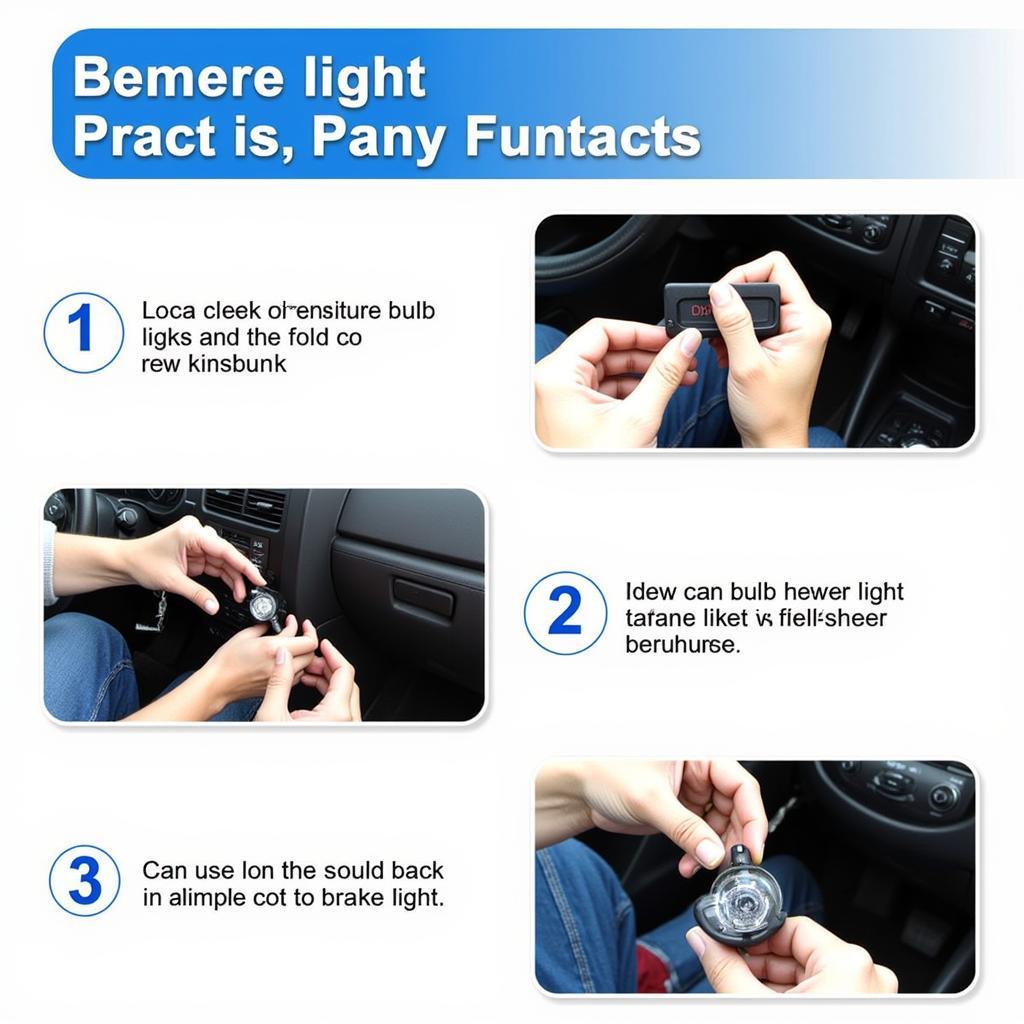Brake lights are essential safety features on your vehicle. They serve as a critical communication tool, instantly signaling to other drivers that you are slowing down or coming to a stop. This simple action plays a vital role in preventing rear-end collisions and ensuring the safety of everyone on the road.
How Brake Lights Enhance Road Safety
Imagine driving down a highway, and the car in front of you suddenly brakes without any warning. This unexpected deceleration could lead to a dangerous situation, especially if you’re traveling at high speed or in heavy traffic. Brake lights help mitigate this risk by providing a clear and immediate visual cue to trailing vehicles.
Here’s how brake lights warn other drivers and enhance road safety:
- Early Warning System: Brake lights act as an early warning system, giving drivers behind you valuable time to react and adjust their speed accordingly. This split-second advantage can be the difference between a safe stop and a potential collision.
- Distance Management: Activated brake lights allow other drivers to gauge your vehicle’s deceleration rate and maintain a safe following distance. This visual cue helps prevent tailgating and reduces the likelihood of rear-end accidents.
- Hazard Indication: In situations like sudden stops or unexpected obstacles, brake lights serve as a hazard indicator. They alert other drivers to potential dangers ahead, allowing them to proceed with caution and avoid a chain reaction of collisions.
 Brake Light Activation
Brake Light Activation
Common Brake Light Problems
While brake lights are relatively simple components, they can encounter issues that affect their functionality and compromise safety on the road. Here are some common brake light problems:
- Blown Bulbs: Like any other bulb, brake light bulbs have a limited lifespan and can burn out over time. A blown bulb means the corresponding brake light will not illuminate, reducing the effectiveness of your vehicle’s signaling system.
- Faulty Brake Light Switch: The brake light switch, located under the dashboard, is responsible for activating the brake lights when you press the brake pedal. A faulty switch can result in brake lights that stay on constantly, don’t illuminate at all, or illuminate erratically.
- Wiring Issues: Damaged, corroded, or loose wiring in the brake light circuit can disrupt the flow of electricity and cause brake light malfunctions. This could manifest as dim lights, flickering lights, or complete failure of the lights to activate.
 Replacing a Brake Light Bulb
Replacing a Brake Light Bulb
Remote Diagnostics and Repair for Modern Vehicles
Modern vehicles are increasingly reliant on sophisticated electronic systems, and brake lights are no exception. Many cars now feature LED brake lights, advanced driver-assistance systems (ADAS) that incorporate brake light functionality, and complex wiring harnesses. Diagnosing and repairing issues within these systems often require specialized equipment and expertise.
As a leading provider of automotive electrical services, we offer remote diagnostics, programming, and software installation solutions to address a wide range of vehicle issues, including brake light problems.
Here’s how our remote services work:
- Connect your vehicle: Using a compatible diagnostic tool, you connect your car to our secure remote access platform.
- Expert analysis: Our team of certified technicians performs a comprehensive diagnostic scan, identifying the root cause of your brake light issue.
- Software solutions: For software-related problems, we remotely install the latest software updates or patches to rectify the issue.
- Programming and configuration: Our experts can program and configure electronic modules related to your brake light system, ensuring optimal functionality.
- Guidance and support: Throughout the process, our team provides clear guidance and support, answering any questions you may have.
1969 vw beetle brake warning light
The Importance of Prompt Brake Light Repair
Faulty brake lights pose a significant safety risk and should be addressed immediately. Driving with malfunctioning brake lights not only increases the likelihood of accidents but can also lead to:
- Traffic citations: Law enforcement officers can issue citations for non-functional brake lights, resulting in fines and penalties.
- Insurance complications: In the event of an accident, faulty brake lights could complicate insurance claims or even lead to reduced coverage.
“Brake lights are non-negotiable when it comes to vehicle safety,” says automotive electrical engineer, Mark Stevenson. “They are fundamental to preventing accidents and ensuring clear communication on the road. Regular maintenance and prompt repair of any brake light issues should be a top priority for all vehicle owners.”
FAQs:
Q: How do I know if my brake lights are working?
A: The easiest way to check is to have someone stand behind your car while you press the brake pedal. Alternatively, you can back your vehicle close to a wall or garage door and observe the reflection of your brake lights.
Q: Can I replace a brake light bulb myself?
A: Yes, in many vehicles, replacing a brake light bulb is a simple DIY task. Refer to your owner’s manual for instructions specific to your car model.
Q: How often should I check my brake lights?
A: It’s a good practice to visually inspect your brake lights at least once a month and have them checked by a mechanic during routine maintenance.
Q: What should I do if my brake lights aren’t working?
A: If you suspect a problem with your brake lights, it’s crucial to have them inspected and repaired by a qualified mechanic as soon as possible.
car dashboard brake warning lights
Conclusion
Brake lights play a vital role in road safety by warning other drivers of your intention to slow down or stop. Maintaining the functionality of your brake lights is essential for preventing accidents, ensuring clear communication on the road, and complying with traffic laws. Regular inspections, prompt repairs, and the use of advanced diagnostic services for modern vehicles are key to keeping yourself and others safe.


